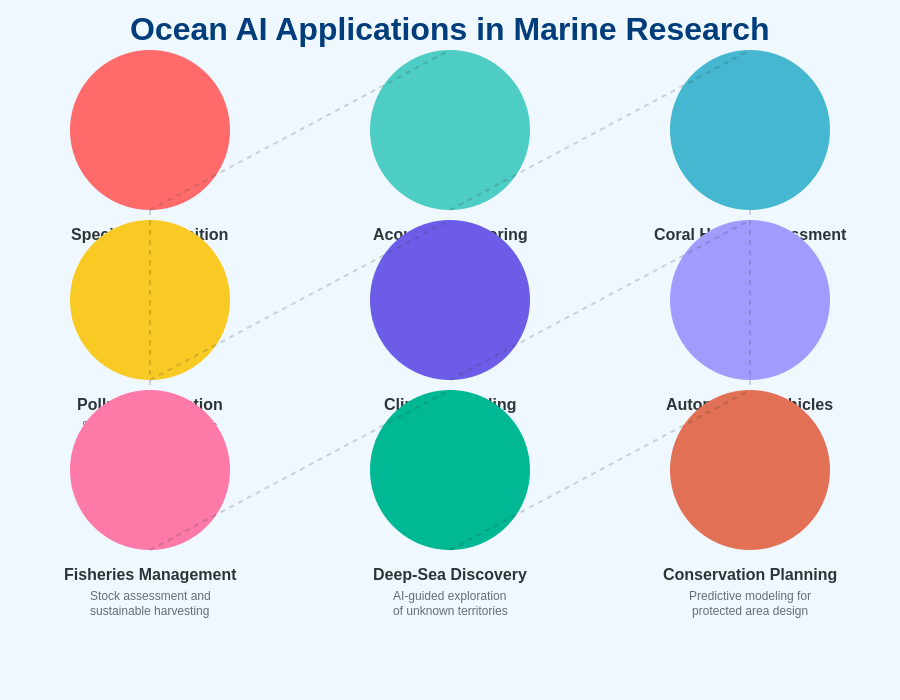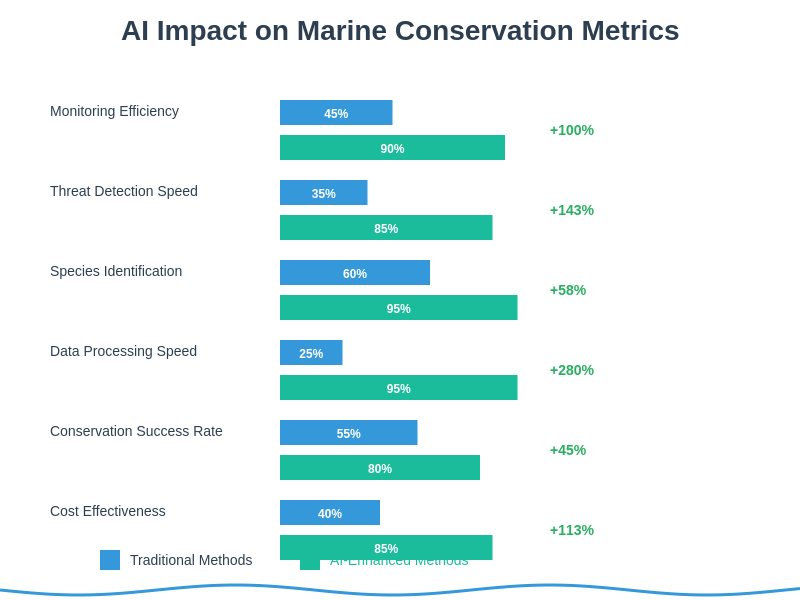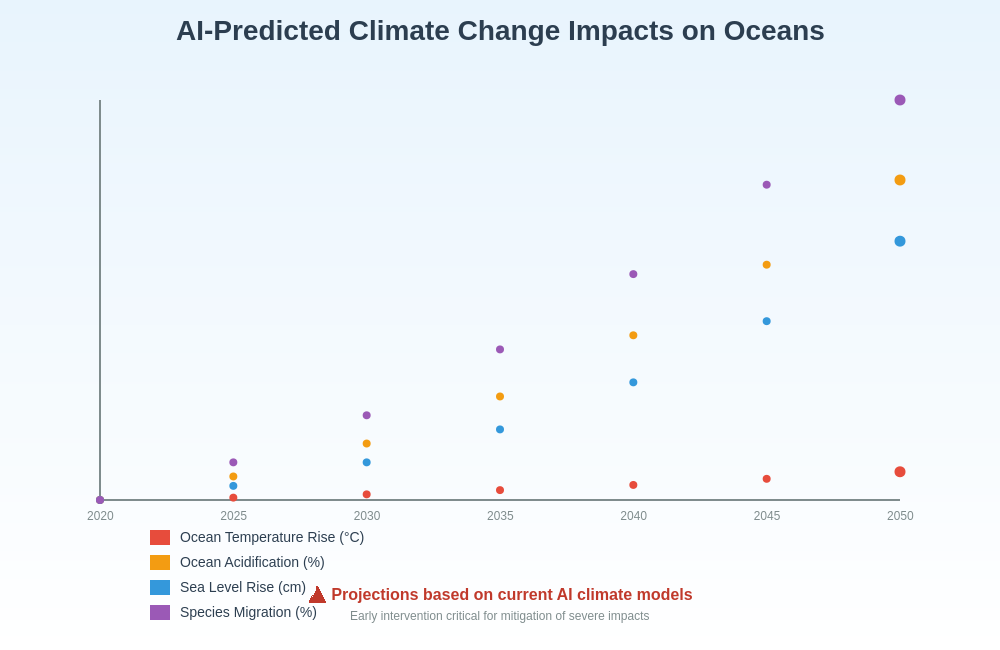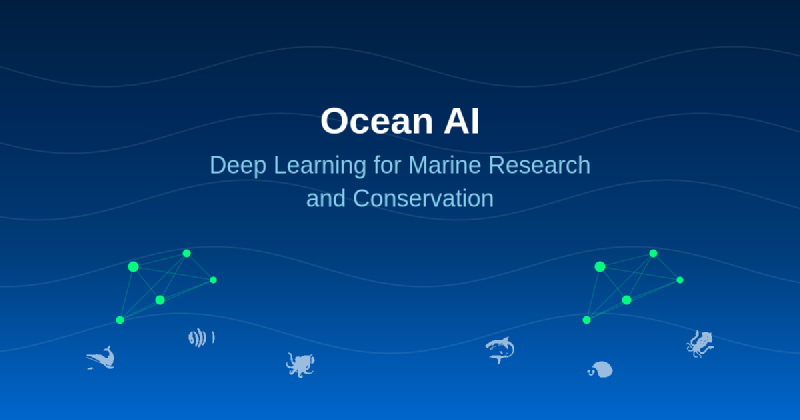The vast expanse of our oceans remains one of Earth’s most mysterious frontiers, with less than twenty percent of the underwater world having been mapped and explored. This immense aquatic realm, covering more than seventy percent of our planet’s surface, harbors countless species, complex ecosystems, and critical environmental processes that remain largely unknown to science. However, the emergence of artificial intelligence and deep learning technologies has opened unprecedented opportunities for marine research and ocean conservation, fundamentally transforming how scientists study, monitor, and protect our marine environments.
Explore the latest developments in AI research to understand how cutting-edge technologies are being applied to environmental challenges and marine science. The integration of artificial intelligence into oceanographic research represents a paradigm shift that promises to unlock the secrets of the deep while providing essential tools for preserving marine biodiversity and combating climate change impacts on ocean systems.
The Revolutionary Impact of AI in Marine Science
The application of artificial intelligence to marine research has created transformative possibilities for understanding ocean dynamics, marine life behavior, and ecosystem health. Traditional oceanographic research methods, while valuable, have been limited by the sheer scale of the oceans, the challenges of underwater data collection, and the complexity of analyzing vast amounts of environmental data. Artificial intelligence has emerged as a powerful solution to these challenges, enabling researchers to process massive datasets, identify patterns in marine life behavior, and monitor environmental changes with unprecedented precision and scale.
Deep learning algorithms have proven particularly effective in analyzing underwater imagery, acoustic data from marine animals, and complex oceanographic measurements. These sophisticated AI systems can identify and classify marine species from photographs and video footage, track migration patterns of marine animals, detect changes in coral reef health, and monitor pollution levels across vast ocean areas. The ability to automate these previously labor-intensive processes has dramatically expanded the scope and efficiency of marine research while reducing costs and increasing the frequency of monitoring activities.
Underwater Computer Vision and Species Recognition
One of the most significant applications of artificial intelligence in marine research involves the development of sophisticated computer vision systems capable of analyzing underwater imagery and video footage. These AI-powered systems can automatically identify and classify marine species, count populations, and monitor behavioral patterns without requiring continuous human oversight. The development of these technologies has been particularly valuable for studying deep-sea environments where human presence is impossible and traditional research methods are extremely expensive and logistically challenging.
Machine learning algorithms trained on extensive databases of marine life imagery can now recognize thousands of different species with accuracy levels that often exceed human capabilities. These systems can distinguish between closely related species, identify individual animals based on unique markings or characteristics, and track the same individuals across multiple sightings over extended periods. This capability has revolutionized population studies, behavioral research, and conservation efforts by providing consistent, objective data collection methods that can be deployed continuously across multiple locations.
Discover advanced AI capabilities with Claude for processing and analyzing complex environmental datasets that support marine conservation efforts and scientific research. The combination of sophisticated machine learning algorithms and extensive marine imagery databases has created powerful tools for understanding ocean ecosystems and tracking environmental changes over time.
Acoustic Monitoring and Marine Animal Communication
The underwater environment presents unique challenges for observation and monitoring, as visual methods are often limited by water clarity, depth, and lighting conditions. However, sound travels efficiently through water, making acoustic monitoring one of the most effective methods for studying marine life. Artificial intelligence has revolutionized acoustic monitoring by enabling automated analysis of underwater soundscapes, identification of individual species based on their vocalizations, and real-time monitoring of marine animal behavior and migration patterns.
Deep learning algorithms can now analyze complex underwater acoustic environments and separate individual animal calls from background noise, identify specific species based on their unique vocal signatures, and track the movements of marine animals across vast ocean areas. These capabilities have proven particularly valuable for studying whale populations, dolphin communities, and other marine mammals whose behavior and migration patterns are critical for conservation efforts. The ability to continuously monitor underwater acoustic environments has provided researchers with unprecedented insights into marine animal behavior, communication patterns, and response to human activities.
Coral Reef Health Assessment and Monitoring
Coral reefs represent some of the most biodiverse and ecologically important marine ecosystems, yet they face unprecedented threats from climate change, pollution, and human activities. Traditional methods for assessing coral reef health have been time-consuming, expensive, and limited in scope, making it difficult to monitor the rapid changes occurring in reef systems worldwide. Artificial intelligence has transformed coral reef monitoring by enabling automated analysis of underwater imagery, rapid assessment of coral health and bleaching events, and continuous tracking of reef ecosystem changes over time.
Machine learning algorithms trained on extensive databases of coral reef imagery can automatically identify different coral species, assess their health status, detect bleaching events, and quantify changes in coral coverage and diversity. These AI systems can analyze thousands of underwater photographs in minutes, providing researchers with comprehensive assessments of reef health that would previously have required months of manual analysis. This capability has enabled more frequent monitoring of coral reefs, earlier detection of environmental stresses, and more rapid response to conservation threats.

The diverse applications of artificial intelligence in marine research demonstrate the transformative potential of these technologies for advancing our understanding of ocean ecosystems and supporting conservation efforts. From automated species identification to real-time environmental monitoring, AI systems are providing researchers with powerful tools for studying the complex dynamics of marine environments.
Oceanographic Data Analysis and Climate Monitoring
The world’s oceans play a crucial role in global climate systems, and understanding oceanic processes is essential for predicting climate change impacts and developing effective mitigation strategies. However, the vast scale of ocean systems and the complexity of oceanic processes have made comprehensive monitoring and analysis extremely challenging using traditional methods. Artificial intelligence has emerged as a powerful tool for analyzing oceanographic data, identifying climate patterns, and predicting future oceanic conditions with unprecedented accuracy and detail.
Machine learning algorithms can process massive datasets collected from ocean buoys, satellite imagery, underwater sensors, and research vessels to identify patterns in ocean temperature, salinity, currents, and chemical composition. These AI systems can detect subtle changes in oceanic conditions that might indicate broader climate trends, predict the formation and movement of ocean currents, and assess the impacts of climate change on marine ecosystems. The ability to analyze and interpret complex oceanographic data in real-time has provided researchers with valuable tools for understanding ocean dynamics and their role in global climate systems.
Marine Pollution Detection and Tracking
Ocean pollution represents one of the most pressing environmental challenges of our time, with plastic waste, chemical contaminants, and other pollutants threatening marine ecosystems and human health. Traditional methods for detecting and tracking marine pollution have been limited by the vast scale of ocean systems and the difficulty of monitoring pollution levels across remote ocean areas. Artificial intelligence has revolutionized pollution monitoring by enabling automated detection of pollutants from satellite imagery, real-time tracking of pollution sources and movement, and comprehensive assessment of pollution impacts on marine ecosystems.
Deep learning algorithms can analyze satellite imagery to identify plastic debris, oil spills, and other pollutants on the ocean surface, track the movement of pollution across ocean systems, and predict the likely impacts of pollution events on marine life and coastal communities. These AI-powered systems can monitor pollution levels continuously across vast ocean areas, providing early warning of environmental threats and enabling more rapid response to pollution incidents. The ability to automatically detect and track marine pollution has significantly enhanced environmental monitoring capabilities and supported more effective pollution prevention and cleanup efforts.
Leverage Perplexity’s research capabilities to access comprehensive information about marine pollution sources, impacts, and mitigation strategies that inform AI-powered monitoring and response systems. The integration of multiple data sources and analytical approaches creates powerful tools for understanding and addressing marine pollution challenges.
Autonomous Underwater Vehicle Intelligence
The development of autonomous underwater vehicles has revolutionized marine research by enabling long-duration, deep-sea exploration and data collection in previously inaccessible ocean areas. However, the effectiveness of these robotic systems has been greatly enhanced through the integration of artificial intelligence technologies that enable autonomous decision-making, adaptive mission planning, and intelligent data collection strategies. AI-powered underwater vehicles can now navigate complex underwater environments, avoid obstacles, identify points of interest, and adapt their missions based on real-time environmental conditions and research objectives.
Machine learning algorithms enable these underwater robots to recognize and respond to unexpected situations, optimize their energy usage for extended missions, and prioritize data collection based on the scientific value of different observations. These intelligent systems can operate independently for weeks or months, collecting valuable scientific data from remote ocean areas while adapting their behavior based on environmental conditions and research priorities. The development of AI-powered autonomous underwater vehicles has dramatically expanded the reach and effectiveness of marine research while reducing costs and risks associated with deep-sea exploration.
Predictive Modeling for Marine Conservation
Conservation efforts in marine environments have traditionally been reactive, responding to environmental threats after they have already caused significant damage to marine ecosystems. Artificial intelligence has enabled the development of sophisticated predictive models that can anticipate environmental threats, predict the likely impacts of human activities on marine ecosystems, and identify optimal conservation strategies before irreversible damage occurs. These predictive capabilities have transformed marine conservation by enabling proactive protection measures and more effective allocation of conservation resources.
Machine learning algorithms can analyze historical environmental data, current conditions, and human activity patterns to predict future threats to marine ecosystems, identify areas at highest risk for environmental degradation, and recommend conservation interventions that are most likely to be effective. These predictive models can forecast the impacts of climate change on specific marine habitats, predict the spread of invasive species, and identify optimal locations for marine protected areas based on ecological connectivity and conservation priorities. The ability to anticipate future environmental challenges has enabled more strategic and effective conservation planning.

The quantitative benefits of AI-powered conservation initiatives demonstrate significant improvements in monitoring efficiency, threat detection speed, conservation success rates, and overall ecosystem protection. These technological advances are enabling more effective stewardship of marine resources and biodiversity.
Fisheries Management and Sustainable Harvesting
Global fisheries face unprecedented challenges from overfishing, climate change, and habitat degradation, threatening both marine ecosystems and the livelihoods of millions of people who depend on fishing for food and income. Traditional fisheries management approaches have often been based on limited data and reactive policies that struggle to keep pace with rapidly changing ocean conditions and fishing practices. Artificial intelligence has emerged as a powerful tool for improving fisheries management by enabling real-time monitoring of fish populations, prediction of stock dynamics, and optimization of fishing practices for long-term sustainability.
Machine learning algorithms can analyze data from fishing vessels, underwater sensors, and satellite imagery to track fish populations, predict migration patterns, and assess the impacts of fishing activities on marine ecosystems. These AI systems can identify optimal fishing locations and timing that maximize catches while minimizing environmental impact, detect illegal fishing activities, and recommend fishing quotas that support long-term stock sustainability. The integration of artificial intelligence into fisheries management has enabled more adaptive and science-based approaches to marine resource management.
Deep-Sea Exploration and Discovery
The deep ocean represents Earth’s final frontier, harboring unknown species, unique ecosystems, and valuable mineral resources that remain largely unexplored due to the extreme challenges of deep-sea research. Traditional deep-sea exploration has been limited by high costs, technical challenges, and the risks associated with operating in extreme underwater environments. Artificial intelligence has revolutionized deep-sea exploration by enabling autonomous systems to operate independently in the deep ocean, identify scientifically interesting features and organisms, and adapt their exploration strategies based on real-time discoveries.
AI-powered exploration systems can analyze underwater imagery and sensor data to identify unusual geological features, unknown species, and scientifically significant phenomena that warrant further investigation. These intelligent systems can prioritize exploration activities based on scientific value, optimize the use of limited exploration time and resources, and document discoveries with unprecedented detail and accuracy. The application of artificial intelligence to deep-sea exploration has accelerated the pace of ocean discovery while reducing the costs and risks associated with deep-ocean research.
Marine Biodiversity Assessment and Monitoring
Understanding and preserving marine biodiversity represents one of the most critical challenges in ocean conservation, requiring comprehensive monitoring of species populations, ecosystem health, and environmental conditions across vast ocean areas. Traditional biodiversity assessment methods have been limited by the time and resources required for species identification, population counting, and ecosystem monitoring. Artificial intelligence has transformed biodiversity monitoring by automating species identification, enabling continuous population tracking, and providing comprehensive assessments of ecosystem health and biodiversity trends.
Machine learning algorithms can analyze underwater imagery, acoustic recordings, and environmental data to identify species, count populations, and assess biodiversity levels across different marine habitats. These AI systems can detect changes in species composition, identify threats to biodiversity, and recommend conservation interventions based on ecosystem health indicators. The ability to continuously monitor marine biodiversity at scale has provided researchers and conservation organizations with valuable tools for tracking ecosystem changes and implementing effective conservation strategies.
Ocean Data Integration and Synthesis
The study of ocean systems generates vast amounts of data from diverse sources including satellites, underwater sensors, research vessels, and autonomous vehicles. Integrating and analyzing these complex, multi-dimensional datasets has traditionally been a major challenge for marine researchers, limiting their ability to develop comprehensive understanding of ocean processes and ecosystem dynamics. Artificial intelligence has emerged as a powerful solution for ocean data integration, enabling researchers to combine diverse data sources, identify patterns across multiple scales, and develop holistic understanding of marine systems.
Machine learning algorithms can process and analyze heterogeneous ocean datasets, identify relationships between different environmental variables, and generate insights that would be impossible to discover through traditional analytical methods. These AI systems can integrate real-time sensor data with historical records, combine local observations with global patterns, and identify emerging trends in ocean conditions and marine life. The ability to synthesize complex ocean data has enhanced scientific understanding of marine systems and supported more informed decision-making for ocean management and conservation.
Climate Change Impact Assessment
Climate change represents one of the most significant threats to marine ecosystems, causing ocean acidification, temperature changes, sea level rise, and alterations in ocean currents that threaten marine life and coastal communities. Understanding and predicting the impacts of climate change on ocean systems requires analysis of complex, interconnected processes that operate across multiple temporal and spatial scales. Artificial intelligence has provided marine scientists with powerful tools for assessing climate change impacts, predicting future conditions, and identifying adaptation strategies for marine ecosystems.
Machine learning algorithms can analyze long-term climate data to identify trends in ocean conditions, predict future changes in marine environments, and assess the vulnerability of different species and ecosystems to climate change impacts. These AI systems can model complex interactions between climate variables and marine systems, identify tipping points in ecosystem stability, and recommend management strategies that enhance ecosystem resilience to climate change. The application of artificial intelligence to climate impact assessment has improved scientists’ ability to understand and predict the effects of climate change on ocean systems.

Advanced AI modeling of climate change impacts on marine ecosystems reveals concerning trends in ocean temperature, acidification levels, and species migration patterns. These predictive insights are essential for developing effective adaptation and mitigation strategies for ocean conservation.
Future Directions and Emerging Technologies
The application of artificial intelligence to marine research and conservation continues to evolve rapidly, with emerging technologies promising even more sophisticated capabilities for understanding and protecting ocean systems. Advanced machine learning algorithms, quantum computing applications, and integrated sensor networks are expected to further enhance the precision and scope of marine research while reducing costs and environmental impacts of research activities. The future of ocean AI will likely involve more sophisticated autonomous systems, enhanced predictive capabilities, and greater integration between different research and monitoring technologies.
The development of artificial general intelligence and more sophisticated machine learning algorithms will enable even more complex analysis of marine systems, including the ability to understand and predict ecosystem-level changes, optimize conservation strategies across multiple objectives, and provide real-time adaptive management recommendations. The integration of AI technologies with advances in underwater robotics, sensor technology, and satellite monitoring will create comprehensive ocean monitoring systems that provide unprecedented insights into marine ecosystems and support more effective conservation and management efforts.
The continued advancement of ocean AI technologies promises to transform our relationship with marine environments, enabling more sustainable use of ocean resources, more effective protection of marine biodiversity, and better understanding of the ocean’s role in global environmental systems. The future of marine science and conservation will be increasingly dependent on artificial intelligence technologies that enhance our ability to study, understand, and protect the world’s oceans for future generations.
Disclaimer
This article is for informational purposes only and does not constitute professional scientific or environmental advice. The views expressed are based on current understanding of AI applications in marine research and conservation. Readers should consult with qualified marine scientists, environmental professionals, and conservation experts when making decisions related to ocean research or conservation activities. The effectiveness of AI technologies in marine applications may vary depending on specific environmental conditions, research objectives, and implementation approaches.
